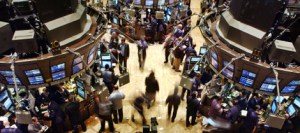
April 29, 2019 | Daily JAM, Morning Briefing, Short Term |
Put today's numbers on the economy together with those in Friday's first quarter GDP report and the picture that emerges is of a U.S. economy growing at s very solid rate with declining inflation. But where the trends on consumer incomes and spending suggest, maybe,...

April 28, 2019 | Daily JAM, Short Term |
... to be drowning in economic data. The Federal Reserve's Open Market Committee meeting on Wednesday, May 1, isn't even the high point of the data week. The U.S. central bank is expected to keep interest rates unchanged so it's Chair Jerome Powell's press conference...

April 7, 2019 | Daily JAM |
... a relatively muted week for economic data--Consumer Price Index inflation on Wednesday (expected core inflation of 0.2% for the month vs 0.1% last month) and initial claims for Unemployment on Thursday (forecast 212,000 versus 202,000 in the prior week)--will let...

March 22, 2019 | Daily JAM, Friday Trick or Trend |
Our regular (or occasional or perhaps occasionally regular) Friday series (actually running on Friday this week) Trick or Trend looks at what might (or might not) be emerging investible trends. Exclusively on JAM. This post won't run anywhere else. Ever. President...

February 13, 2019 | Daily JAM, Morning Briefing |
For January, headline Consumer Price Index (CPI) inflation was unchanged, thanks to falling oil prices-the energy component of the index was down 3.1% for the month. The Core CPI, which excludes more volatile food and energy prices and is closer to the PCE inflation...

December 30, 2018 | Daily JAM |
... everything in the way of economic news to get crammed into Thursday and Friday after a quiet start to the week. On Thursday, investors and traders get news on initial claims for unemployment (How strong is the job market?), the purchasing managers index for the...

December 12, 2018 | Daily JAM |
The core Consumer Price Index (CPI), a broad inflation measure that excludes volatile Food and energy prices, rose 0.2% in November from October. This core inflation rate is now up 2.2% over the last 12 months, an increase from a 2.1% rate in October, according to the...

November 9, 2018 | Daily JAM, Morning Briefing |
The 3.1% year over year growth in average hourly wages reported for October is, by itself, enough to convince the Federal Reserve that an increase in inflation, long awaited with concern, is visible on the horizon. Today's jump in the Producer Price Index (PPI) for...

October 29, 2018 | Daily JAM, Morning Briefing |
The savings rate dipped in September, the Commerce Department reported this morning. Americans. Americans saved 6.2% of their disposable income, the lowest level since 2013. Incomes grew by just 0.2%, the weakest in more than a year. That's not good news considering...

October 11, 2018 | Daily JAM, Short Term |
A Big Bad Wolf market? A Sauron market? An Evil Stepmother market? The reaction to this morning's inflation report suggests me might need a name for this kind of market. The worry, my worry, going into today's Consumer Price Index (CPI) inflation report from the...

October 10, 2018 | Daily JAM, Short Term |
At 3:30 p.m. New York time the Dow Jones Industrial Average was down a big 2.39% or 632 points. The Standard & Poor's 500 was lower by 2.55%. The NASDAQ Composite Index fell 3.16%. The rout came on fears that the U.S.-China trade war would cut into U.S., Chinese,...

September 28, 2018 | Daily JAM, Notes You Need |
In my daily trawling through the market I come upon lots of tidbits of knowledge that I think are important to investors but that don't justify a full post. I've decided to start compiling these notes here each day in a kind of running mini blog that I'm calling Notes...
















